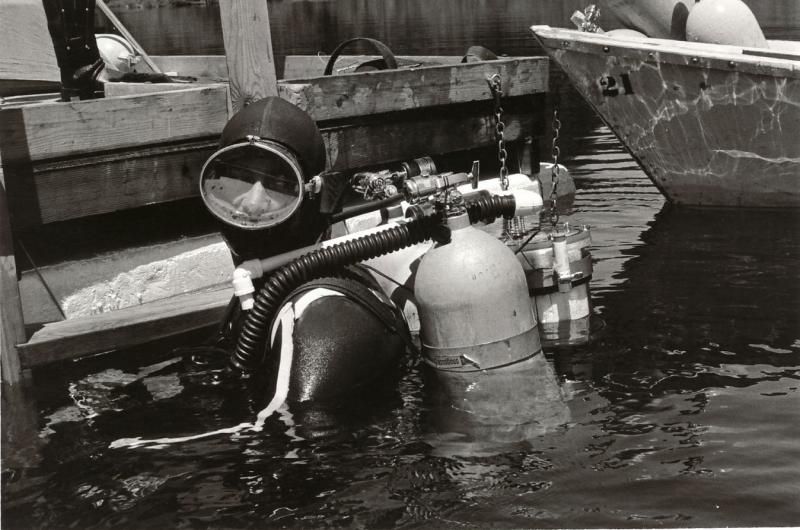|
|
Post by SeaRat on May 24, 2013 20:23:48 GMT -8
I found this video on You Tube, and thought you'd enjoy it.
As you watch it, note the good positioning of the Mistral regulator on the diver's back.
John
|
|
|
|
Post by CG-45.com on May 25, 2013 5:27:38 GMT -8
Very nice!! Thanks for sharing!
|
|
|
|
Post by nikeajax on May 25, 2013 10:44:45 GMT -8
John, in the opening credits you see the name Jim Steele; this is the sign for his shop:   I may be wrong, but I don't think so; those tanks she's wearing are Healthways! I'm certain they are the ones he keeps right up front, 'cause the wooden handle on the side makes me drool every time I go into his shop! Jaybird |
|
|
|
Post by SeaRat on May 25, 2013 20:06:39 GMT -8
John, in the opening credits you see the name Jim Steele; this is the sign for his shop:   I may be wrong, but I don't think so; those tanks she's wearing are Healthways! I'm certain they are the ones he keeps right up front, 'cause the wooden handle on the side makes me drool every time I go into his shop! Jaybird Wow, that sign has seen a lot; did he pull it out of the sea? Looks like there's a gang around too. My, oh my... Here's the first in this series, complete with a doff and don. www.youtube.com/watch?v=06hk5PzoZPo&list=UU7BMUSQEFdJlMGwiScWGuVQ&index=9But she gets a couple of small, technical things wrong. See if you can figure out where the mistakes are found. Also, look at the placement of the Aquamaster regulator when used on a single tank verses the double tank system she used in the second of this series above. Now, if you want to see something really delightful, take a look at her underwater dance work, Reflections in Pink: John |
|
|
|
Post by nikeajax on May 27, 2013 10:00:56 GMT -8
Is it that her nail-polish doesn't match her bathing suit?  Sorry; it just wouldn't be me if I didn't give you an answer like that, now would it... The regulator is too high, and the straps aren't tight enough--sometimes it's hitting her in the ear! Jaybird |
|
|
|
Post by SeaRat on May 27, 2013 17:08:43 GMT -8
I was thinking of the "blocking" method of clearing your ears with an oval mask without finger pockets. She obviously was never told of that method. She also talked of the mouthpiece exhalation valve as if it was the only one in the mouthpiece, not even mentioning the inhalation non-return valve. There was no pull rod on her J-valve either, although there is a place for one on the backpack's tank band. Those are the ones I can think of without watching again. I love her underwater ballet in Reflections in Pink, except the ending: www.youtube.com/watch?v=g64VUswybQ8&list=UU7BMUSQEFdJlMGwiScWGuVQJohn |
|
|
|
Post by nikeajax on May 28, 2013 12:20:00 GMT -8
John, I'm sure I know how to do this, but not by the name "blocking", was looking up masks in "The New Science of Skin and Scuba Diving" and also "Basic Scuba", I may have missed something though. Her method seems overly complicated to do repetedly!
As a side note, Fred Roberts mentions that some SH-regs don't have a purge-valve, pg-342: gosh, which ones don't
Jaybird
|
|
|
|
Post by SeaRat on May 28, 2013 20:44:05 GMT -8
John, I'm sure I know how to do this, but not by the name "blocking", was looking up masks in "The New Science of Skin and Scuba Diving" and also "Basic Scuba", I may have missed something though. Her method seems overly complicated to do repetedly! As a side note, Fred Roberts mentions that some SH-regs don't have a purge-valve, pg-342: gosh, which ones don't Jaybird Jaybird, see the Rose Aviation Pro and Super Pro regulators (page 136-138 in Basic Scuba). Concerning the clearing of ears, it is not too clear (pun intended) in the New Science of Skin and Scuba Diving, as they talk about different ways of equalizing, without going into the techniques: Hans Hass used a nose clip under the mask to help with equalizing; I've tried it, and it's a pretty neat way to go. You can get free nose clips at the bottom of most pools after a competition platform diving or water ballet event too. But I've never had much problem. The technique is to push up on the bottom of the mask skirt, and if that doesn't block the nose then push up with your thumb and bent forefinger to block the nose. Wiggle your jaw as you blow gently out and ears will clear easily without a finger pocket in the mask. Here's a series of dives I made on June 14, 1971 as part of a University of Oregon physiological experiment on divers. I made 6 scuba dives for research as a subject (two sets of dives on a horizontal line at 3 feet, 37 feet, and 73 feet), 5 dives as an assistant diver, safety man and photographer, and three breath-hold dives for research too ((to 30, 50 and 25 feet). Note my mask:  It's a Champion Deluxe mask from USD (blue, as I remember). I just found a replacement a few months back, so I again have this mask. The water temperature was 37 degrees F (almost 3 degrees C), and I wasn't about to take my mask off the clear my ears. John |
|
|
|
Post by nikeajax on May 29, 2013 8:45:54 GMT -8
I think it was in Basic Scuba, but one of those books talks about leaving water in your mask to keep it from fogging up: I always wondered why Lloyd Bridges had water in his mask in a lot of the close-ups!
Jaybird
|
|
|
|
Post by sitkadiver on May 29, 2013 10:47:35 GMT -8
OK John,
What can you tell us about your set-up in that photo? Looks like a set of doubles with a USD single hose reg on the left hand tank but the right hand tank is facing backwards/sideways or something. There is what appears to be a charcoal canister in the center with a wire coming off the little doo-hicky on the sied of that..... And the PVC and corrugated hose? Is that a capture suction tube? Why the enlarged section in the center?
Definately curious about this one.
|
|
|
|
Post by nikeajax on May 29, 2013 16:26:58 GMT -8
Concerning the Rose Aviation: yes, I see now. Am I correct in believing that's a tilt-valve? I didn't think the ending of her video was that bad, but gosh, how did she hold her breath for over six-minutes  Jaybird |
|
|
|
Post by sitkadiver on Apr 3, 2014 16:27:26 GMT -8
|
|
|
|
Post by nikeajax on Apr 4, 2014 9:07:18 GMT -8
Dave, I wish you could have seen his shop about a year ago, $#!+ was strewn everywhere--it was awesome! His wife has since put stuff in display cases, but all the regulators, and parts of said regs any and everywhere, nearly anything you could imagine. He gave me a USD purge-button label yesterday: I asked him what he wanted for it, thought about it for a second, then, "You can have it..." I can imagine what his basement must look like--YEEEEHAW!
Jaybird
|
|
|
|
Post by SeaRat on Apr 5, 2014 7:53:30 GMT -8
OK John, What can you tell us about your set-up in that photo? Looks like a set of doubles with a USD single hose reg on the left hand tank but the right hand tank is facing backwards/sideways or something. There is what appears to be a charcoal canister in the center with a wire coming off the little doo-hicky on the sied of that..... And the PVC and corrugated hose? Is that a capture suction tube? Why the enlarged section in the center? Definately curious about this one. Sitkadiver, 'Sorry it has taken me so long to respond about this dive. These dives occurred on June 14th and June 16, 1971. I had just returned from Vietnam (discharged from DaNang at Norton AFB, CA on June 10, 1971), and learned of a research project being conducted by two researchers at the University of Oregon. Here's what my dive logs state: The gear was very interesting. One tank of the triples was under a vacuum, and collected samples of my exhalations, so you are correct in that this was a capture/suction tube for my exhalations. One tank was calibrated and used to monitor the amount of air used during the experiment, and one tank was for getting to the experiment, and ascending after the experiment. It was quite heavy too. The canister actually housed electronic equipment to monitor my heart rate and electrocardiogram. This was the time of analog equipment, so it had to be large enough to actually run a paper strip while I was diving. We had to do a switch to use only the experimental regulator during the experiment, and the other regulator when the experiment was completed. We swam a horizontal line at specific depths, 3 feet, 37 feet and 73 feet (2 atmospheres absolute pressure, 3 atmospheres absolute and 4 atmospheres absolute--the changes were because we were at altitude and in fresh water, so we could not use the standard 0, 33 feet and 66 feet, as those are for salt water at sea level). The breath-hold dives were to 30 feet and 50 feet for one minute, and 25 feet for 30 seconds (no mask--that was difficult in the cold water, but they wanted it to see if that influenced the diving reflex). Water temperature for all the dives, which were conducted in Clear Lake in the Cascade Mountains east of Eugene, Oregon was 42 degrees F (not the 37 degrees F reported in the other entry; it is 37 degrees at the head of the lake, but this was in the main body of the lake). Visibility ranged from 20 to 30 feet, as this was not the spring area of the lake. (I have all this data from my dive log entries at the time.) Unfortunately, I don't have a copy of their results--I may try to get it through the University of Oregon just to satisfy my curiosity. I did find that Joe Russell attended a symposium in Florida titled "SCIENTIST-IN-THE-SEA: PAST, PRESENT, AND FUTURE TRAINING OPPORTUNITIES FOR DIVING SCIENTISTS," and that this paper about that conference is in the Rubicon Foundation Research Library: dspace.rubicon-foundation.org:8080/xmlui/bitstream/handle/123456789/8066/AAUS_2000_26.pdf?sequence=1So maybe my diving helped him get his Ph.D. in Exercise Physiology from the University of Oregon. John    Descending the line with the equipment..........At the depth, clearing my ears..........Getting out after the experiment |
|
|
|
Post by sitkadiver on Apr 5, 2014 11:18:42 GMT -8
John, Looks heavy. Hope this makes it into your memoir.
|
|